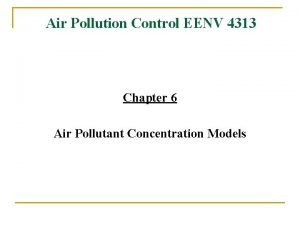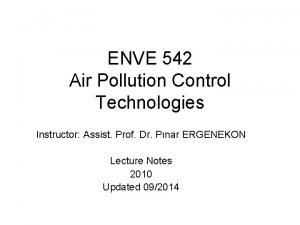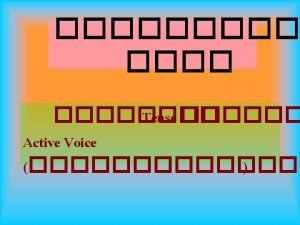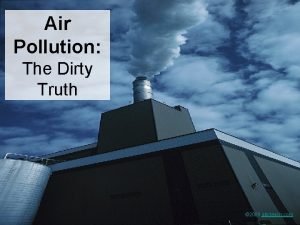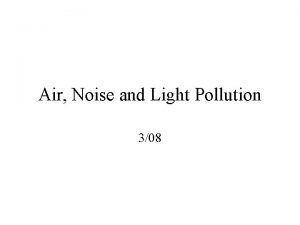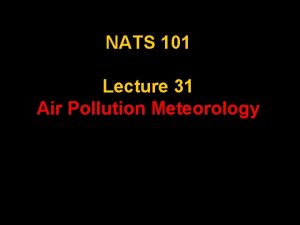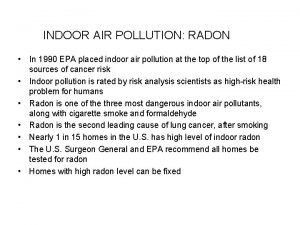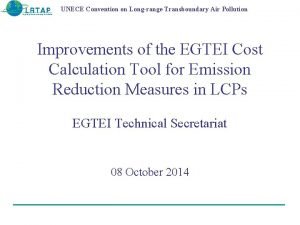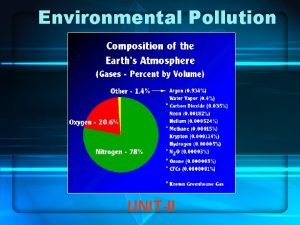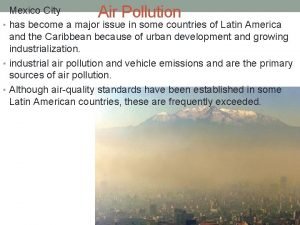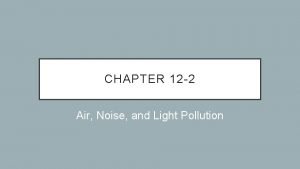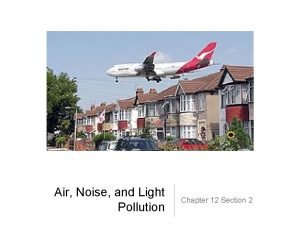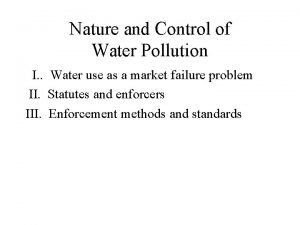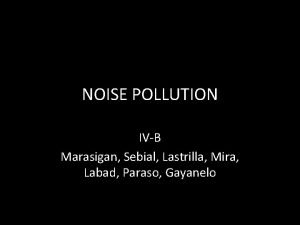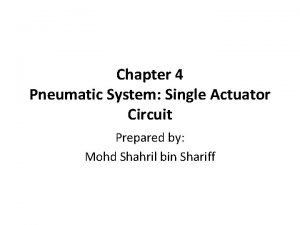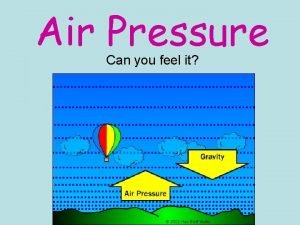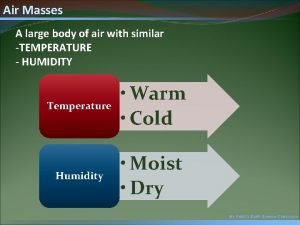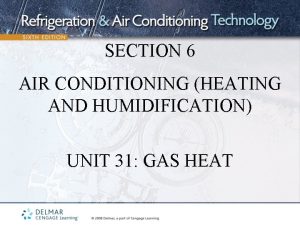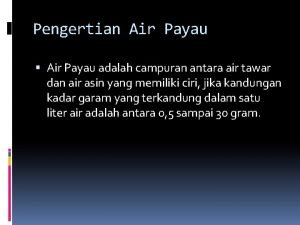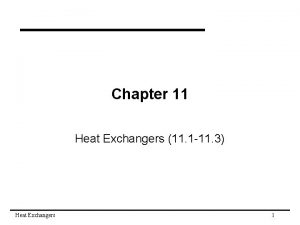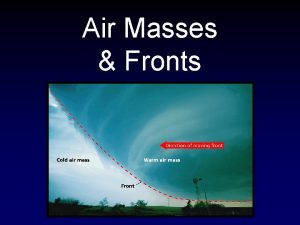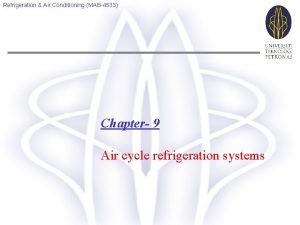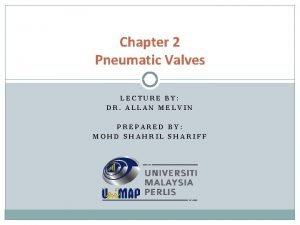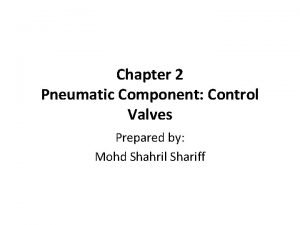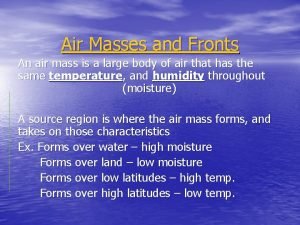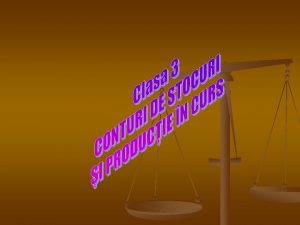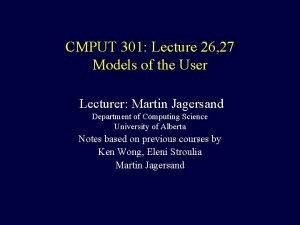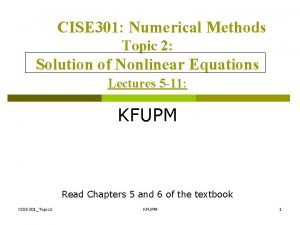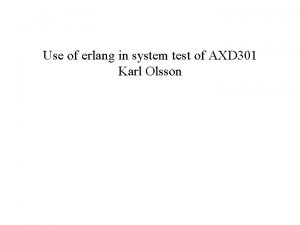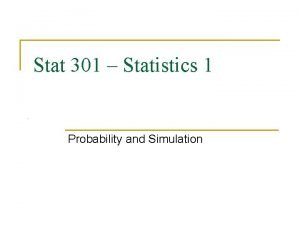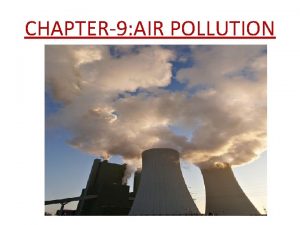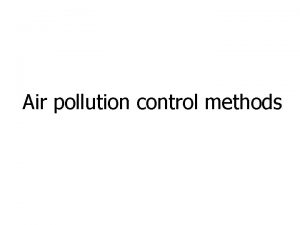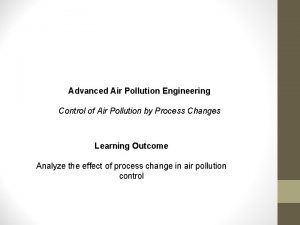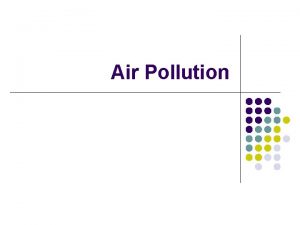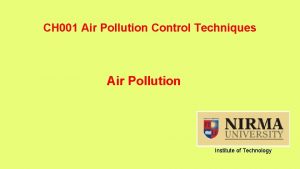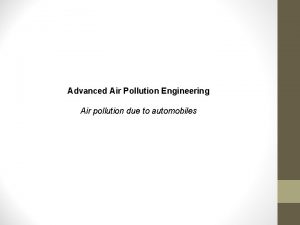EAT 301 AIR POLLUTION ENGINEERING CONTROL OF PRIMARY


















































































































- Slides: 114

EAT 301| AIR POLLUTION ENGINEERING CONTROL OF PRIMARY PARTICULATES

Course Outline| 1. 1. 1 1. 2 2. 2. 1 2. 2 2. 3 3. 3. 1 3. 2 3. 3 3. 4 4 5 Introduction Characteristics of particles (aerodynamic diameter) Particle size distribution Wall collection devices Gravity settlers Centrifugal separators Electrostatic precipitators Dividing collection devices Surface filters Depth filters Filter media Scrubbers for particulate control Choosing a collector Summary EAT 301

Introduction| Section 1 1 EAT 301 Particulate matter refers to everything emitted in the form of a condensed (liquid or solid) phase. 2 These suspended particles vary in size, composition and origin. 3 It is convenient to classify particles by their aerodynamic properties because: 4 5 they govern the transport and removal of particles from the air; they also govern their deposition within the respiratory system; and they are associated with the chemical composition and sources of particles.

EAT 301 Introduction |terminology Particulate Description Section 1 1 2 Suspended particulate matter (SPM), and total suspended particles (TSP) Total airborne particles; often as measured by a high-volume sampler without a sizeselective inlet Particulate matter (PM) PM 10 is the mass concentration of particulate matter (PM) due to particles that pass through a size-selective inlet that has 50% efficiency at an aerodynamic diameter of 10 μm. PM 2. 5 is the corresponding concentration for a cut diameter of 2. 5 μm. Fine particles Those smaller than a few μm. Sometimes used synonymously with PM 2. 5. Ultrafine particles or nanoparticles. Those smaller than about 0. 2 μm, normally expressed in nm. 3 4 5

EAT 301 Introduction |terminology Particulate Section 1 1 Description Aerosol Any solid or liquid particles of aerodynamic diameter ranging from sub-micron to several microns that remain suspended in the air. Common usage refers to the aerosols as the particulate component only 4 Grit The coarsest fraction of material usually formed by a mechanical process such as crushing or grinding. Size range is sometimes defined. 5 Dust As for grit but smaller, typically greater than 1 μm Smoke. Particles formed by incomplete combustion, as a mixture of carbon and condensed volatiles. Usually less than 1 μm. 2 3

EAT 301 Introduction |terminology Section 1 1 Particulate Black smoke. Suspended particulate as determined by the reflective stain method. Size range not specified, but later measurements have shown no particles sampled above 10 μm aerodynamic diameter, and a 50% cut at about 4 μm, so the measurement would correspond to the respirable fraction. ACGIH and ISO conventions. The human breathing system has evolved to filter out large particles at an early stage, and the proportion of particles reaching the lungs depends strongly on particle size. The American Conference of Government Industrial Hygienists (ACGIH) and the International Organization for Standardization (ISO) have defined particle fractions on this basis. 2 3 4 5 Description

Introduction | Characteristics of particles Section 1 1 2 3 4 5 EAT 301 The most important characteristic of particulate matter (PM) is the particle size because it has the greatest impact on the behaviour of particulate matter in control equipment, the atmosphere, and the respiratory tract. The chemical composition of the particulate matter is also important. Absorption and heterogeneous nucleation of vapor phase pollutants onto existing particles can create toxic particulate matter. Other characteristics (include stickiness, resistivity, explosiveness) should be considered when selecting an appropriate particulate control device for a gas stream.

Introduction | aerodynamic diameter Most particles less than 2. 5 micrometers are formed by the following mechanisms: a. Heterogeneous nucleation of vapor phase material b. Homogeneous nucleation of vapor phase material c. Atmospheric reactions of gases to form vapors that homogeneously and heterogeneously nucleate to form particles CLICK HEE FOR MORE INFO Particles classification by US EPA.

Introduction | aerodynamic diameter Section 1 1 2 3 4 5 EAT 301 A particle size is usually expressed in terms of its aerodynamic diameter instead of its actual or physical diameter. Aerodynamic Diameter The diameter of a spherical particle having a density of 1 g/cm 3 that has the same inertial properties (i. e. settling velocity) in the gas as the particle of interest.

Introduction | aerodynamic diameter Section 1 1 2 3 4 5 EAT 301 The Stokes diameter for a particle is the diameter of the sphere that has the same density and settling velocity as the particle. It is based on the aerodynamic drag force caused by the difference in velocity of the particle and the surrounding fluid. For smooth, spherical particles, the Stokes diameter is identical to the physical or actual diameter.

Introduction | aerodynamic diameter Particles that appear to have different physical sizes and shapes can have the same aerodynamic diameter as illustrated below CLICK HEE FOR MORE INFO

Introduction | aerodynamic diameter Conversely some particles that appear to be visually similar can have somewhat different aerodynamic diameters as illustrated below. CLICK HEE FOR MORE INFO

Introduction| Example 1: aerodynamic diameter Calculate the diameter (dpa) of a particle having a Stokes diameter (dps) of 2. 0 micrometers and a density of 2. 7 gm/cm 3. Calculate also: i. if the Stokes diameter is doubled. ii. if the particle is twice as dense. Answer: 3. 29 µm, 6. 57 µm, 4. 65 µm CLICK HEE FOR MORE INFO

Source: Ebert, M. , Weinbruch, S. , Hoffmann, P. and Ortner, H. M. (2000) ‘Chemical characterisation of North Sea aerosol particles’, J Aerosol Science 31(5): 613– 32. Introduction |aerosol mechanics (A) irregularly shaped sea-salt particle; (B) sea-salt particle with typical cubic morphology (1), irregularly shaped sea-salt particle (2), and alumosilicate particle (3); (C) aged sea-salt particle; (D) biological particle (1), Si-rich fly ash particle (2), and various soot particles (diameter of primary particles below 100 nm).

Source: Ebert, M. , Weinbruch, S. , Hoffmann, P. and Ortner, H. M. (2000) ‘Chemical characterisation of North Sea aerosol particles’, J Aerosol Science 31(5): 613– 32. Introduction | aerosol mechanics (E) soot agglomerate (1) with alumosilicate particles (2, 4), and carbonaceous material (3); (F) alumosilicate particle (clay material); (G) two alumosilicate fly ash particles; (H) agglomeration of iron oxide spheres

Source: Ebert, M. , Weinbruch, S. , Hoffmann, P. and Ortner, H. M. (2000) ‘Chemical characterisation of North Sea aerosol particles’, J Aerosol Science 31(5): 613– 32. Introduction | aerosol mechanics (I) calcium sulphate (presumably gypsum) particle (1), spherical iron oxide particle (2), and titanium oxide particle (3); (J) typical soot agglomerate; (K) biological particle (1) and seasalt (2); (l) agglomerate of carbonaceous material (1, 2), alumosilicates (3), Si-rich fly ash (4), and calcium sulphate (5, 6).

Introduction |particle size distribution The scale of ‘air’ molecules relative to the separation between them and the mean free path.

Introduction |particle size distribution Size Distribution and Sources of Atmospheric Particles

Wall collection devices | 2 1 2 EAT 301 Several factors must be considered when selecting an appropriate particulate control device. Characteristics that must be considered include: the particle size and resistivity 3 4 exhaust flow rate Temperature moisture content, and 5 various chemical properties of the exhaust stream (explosiveness, acidity, alkalinity, and flammability)

Wall collection devices | 2 1 2 3 4 5 EAT 301 combination of multiple devices yields the best collection efficiency. For example, a settling chamber can be used to remove large particles from the exhaust stream before it enters an electrostatic precipitator where smaller particles are removed. The first three types of control devices we consider-gravity settlers, cyclone separators, and electrostatic precipitators-all function by driving the particles to a solid wall, where they adhere to each other to form agglomerates that can be removed from the collection device and disposed off.

Wall collection devices |Gravity settlers 2 1 2 3 4 5 EAT 301 The mathematical analysis for gravity settlers is very easy; it will reappear in modified form for cyclones and electrostatic precipitators.

Wall collection devices |Gravity settlers 2 1 EAT 301 Used in conjunction with a more efficient control device. 2 3 4 5 Use the force of gravity to remove solid particles. The gas stream enters a chamber where the velocity of the gas is reduced. Large particles drop out of the gas and are recollected in hoppers.

Wall collection devices |Gravity settlers Horizontal flow settling chamber

Wall collection devices |Gravity settlers Multi-tray settling chamber

Wall collection devices |Gravity settlers 2 1 2 models: Either we assume that: I. the fluid going through is totally unmixed (block flow or plug flow model) or II. the total mixing, either in the entire device or in the entire cross section perpendicular to flow (back mixed or mixed model). 2 3 4 5 EAT 301 For either block or mixed flow, the average horizontal gas velocity in the chamber is

Wall collection devices |Gravity settlers H

Wall collection devices |Gravity settlers EAT 301 Block flow model 2 1 Assumption 2 3 4 i. The horizontal velocity of the gas in the chamber is equal to Vavg everywhere in the chamber. ii. The horizontal component of the velocity of the particles in the gas is always equal to Vavg. iii. The vertical component of the velocity of the particles is equal to their terminal settling velocity due to gravity, Vt. 5 iv. If a particle settles to the floor, it stays there and is not re-entrained.

Wall collection devices |Gravity settlers 2 1 2 EAT 301 Consider a particle that enters the chamber some distance h above the floor of the chamber. The length of time the gas parcel it entered with will take to traverse the chamber in the flow direction is 3 4 During that time the particle will settle by gravity a distance 5 What happens if this distance is greater than or equal to h?

Wall collection devices |Gravity settlers If all the particles are of the same size (have the same value of vt), then there is some distance above the floor (at the inlet) below which all of the particles will be captured, and above which none of them will be captured. 2 1 2 3 If all the particles are distributed uniformly across the inlet of the chamber, 4 5 EAT 301

Wall collection devices |Gravity settlers To compute the efficiency-particle diameter relationship, we replace Vt in Eq. (1) with the gravity-settling relations described (Stokes’ law equation) and find 2 1 2 3 4 5 EAT 301

Wall collection devices |Gravity settlers EAT 301 Mixed flow model 2 1 Assume that the gas flow is totally mixed in the z direction but not in the x direction. 2 Mixing in the z direction leads to a decrease in collection efficiency. 3 dx is a section of the settler with length, in which: 4 5 The change in concentration passing this section is

Wall collection devices |Gravity settlers EAT 301 The time the average particle takes to pass through this section is 2 1 2 Combining these equations and rearranging, we have 3 4 Integrating from the inlet (x = 0) to the outlet (x = L), finding 5

Wall collection devices |Gravity settlers 2 1 2 EAT 301 Or Finally we can substitute for Vt from Stokes’ law, finding 3 4 5 Comparing this result with that for the block flow, Eq. (2), we see that Eq. (3) can be rewritten as Always remember, for viscosity of air

Wall collection devices | Example 2 Compute the efficiency-diameter relation for a gravity settler that has H = 2 m, L = 10 m, and Vavg = 1 m/s for both the block and mixed flow models, assuming Stokes’ law. Solution: Here we can get the result using only one computation and then using ratios First we compute the block efficiency for a 1 -µ particle, viz. , CLICK HEE FOR MORE INFO The mixed assumption leads to practically the same result, viz. ,

Wall collection devices | Problem 2 To find the efficiencies for other particle diameters, we observe that the block efficiency is proportional to the particle diameter squared, so we make up a table of block flow efficiencies by simple ratios to the value for 1µ, and then compute the corresponding mixed flow efficiencies as just shown. Particle diameter, µ 1 10 ηblock (%) ηmixed (%) 0. 0303 3. 03 2. 98 30 27. 3 23. 9 50 76. 0 53. 0 57. 45 100. 0 CLICK HEE FOR MORE INFO 63. 0 80 - 86. 0 100 - 95. 0 120 - 99. 0 These values are shown in Fig. 9. 2

Wall collection devices | Problem 2 CLICK HEE FOR MORE INFO

Wall collection devices | Problem 2 From Eq. (2), , the gravity settler would be useful for collecting particles with diameters of perhaps 100µ (fine sand) but not for particles of air pollution interest. We would increase the efficiency by making L larger (expensive), by making H smaller (which is sometimes done by subdividing the chamber with horizontal plates, which makes the cleanup much more difficult), by CLICK HEE FOR MORE INFO lowering Vavg (expensive), or by increasing g.

Wall collection devices | Assignment 1 a Estimate the collection efficiency of a 75 μm diameter particle in a simple settling chamber 10 ft (3. 048 m) wide by 10 ft high by 30 ft (9. 144 m) long when the gas velocity through the chamber is 5 ft/s (1. 524 m/s). Assume a particle density of 120 lbm/ft 3 (1922. 2 kg/m 3) and gas stream conditions of 68°F (20 o. C) and 1 atm (101. 325 k. Pa). CLICK HEE FOR MORE INFO

Wall collection devices | Assignment 1 b Compute the efficiency-diameter relation for a gravity settler that has H = 4 m, L = 10 m, and Vavg = 1. 0 m/s for both the block and mixed flow models, assuming Stokes’ law. CLICK HEE FOR MORE INFO

Wall collection devices |Gravity settlers 2 1 2 3 4 5 EAT 301

Wall collection devices |Centrifugal separators 2 1 2 3 4 5 What is centrifugal separators? A machine that uses centrifugal, gravitational, and inertial forces to divide two or more substances. Centrifugal separation occurs when a mixture in the machine's chamber is spun very quickly, and heavy materials typically settle differently than lighter ones. Also referred as mechanical collectors EAT 301

Wall collection devices |Centrifugal separators 2 1 2 3 4 5 How does a centrifugal separator works? The particulate-laden gas stream is forced to spin in a cyclonic manner. The mass of the particles are driven to the wall by centrifugal force, where they collect, attach to each other, and form larger agglomerates. Most of the large-diameter particles enter a hopper below the cyclonic tubes while the gas stream turns and exits the tube. EAT 301

Wall collection devices |Centrifugal separators Types of mechanical collectors Large-diameter cyclones Small-diameter multicyclones Roto. Clones

Wall collection devices |Centrifugal separators

Wall collection devices |Centrifugal separators 2 1 2 3 4 5 EAT 301 Large diameter cyclones Small diameter multicyclones Range in size from approximately 1 ft in diameter to more than 12 feet in diameter Multi-cyclone collectors are groups of small diameter cyclones, typically 6 inches to 12 inches in diameter Used for the collection of large diameter particulate matter that would otherwise settle out near the source and create a nuisance in the immediate area Have better particulate removal capability than large diameter cyclones. Used as stand-alone collectors on sources generating moderate-to-large particulate matter and are also used as pre-collectors to reduce the particle loading into fabric filters and electrostatic precipitators

Wall collection devices |Centrifugal separators If a body moves in a circular path with radius r and velocity vc along the path, then it has angular velocity ω = vc / r, and 2 1 2 3 4 5 EAT 301

Wall collection devices | Example 3 A particle is travelling in a gas stream with velocity 60 ft/s (18 m/s) and radius 1 ft (0. 3048 m). What is the ratio of centrifugal force to the gravity force acting on it? Solution:

Wall collection devices |Centrifugal separators For further work we will use a centrifugal equivalent of Stokes’ law. 2 1 The terminal settling velocity in the radial direction Vt and the velocity along the circular path Vc. 2 3 4 5 EAT 301

Wall collection devices |Centrifugal separators Substituting the centrifugal acceleration for the gravitational one in the equation for Vt and dropping the ρf term, we find 2 1 2 3 4 5 EAT 301

Wall collection devices | Example 4 Compute the terminal settling velocity in air of a sphere with diameter 1 µm, in a circular gas flow with velocity Vc = 60 ft/s (18. 29 m/s) and radius 1 ft (0. 3048 m). The density of the fluid can be ignored. Solution:

Wall collection devices |Centrifugal separators

Wall collection devices |Centrifugal separators 2 1 2 3 4 5 EAT 301 Gas enters through a rectangular inlet, twice as high as it is wide, to the circular body of the cyclone Only the outer helix contributes to collection; equivalent to gravity settler. The comparable distance in a gravity settler is H. The inlet stream has a height Wi in the radial direction (maximum distance any particle must move to reach the wall). The length of the flow path is NπD 0, (N = the number of turns that the gas makes traversing the outer helix of the cyclone, before it enters the inner helix, Do = the outer diameter of the cyclone) L is the length of the flow path corresponds that in the gravity settler.

Wall collection devices |Centrifugal separators Making these substitutions directly into the gravity settler equations, Eqs. (2) and (3); 2 1 2 3 4 5 EAT 301 and

Wall collection devices |Centrifugal separators 2 1 EAT 301 If we then substitute the centrifugal Stokes’ law expression, Eq. (5), into these two equations, we find 2 3 and 4 5 A value of N = 5 represents the experimental data best.

Wall collection devices | Example 4 Compute the efficiency-diameter relation for a cyclone separator that has Wi = 0. 5 ft (0. 1524 m), Vc = 60 ft/s (18. 288 m/s), and N = 5, for both the block and mixed flow assumptions, assuming Stokes’ law. Assume SG = 2. 00 Solution: For a 1 -µ particle,

Wall collection devices | Example 4 Particle diameter, µ 0. 1 1 2 3 4 5 6. 559 10 15 ηblock (%) 0. 000232 0. 0930 0. 209 0. 372 0. 582 1. 00 - ηmixed (%) 0. 000232 0. 0230 0. 0888 0. 189 0. 311 0. 441 0. 632 0. 902 0. 995

Wall collection devices | Example 4 Identical plot, but with the diameter scale multiplied by a factor of The models and their resulting equations are truly same except for the substitution of centrifugal force for gravity and the change in dimensions

Wall collection devices |Centrifugal separators 2 1 2 3 4 5 EAT 301 If we considered only spherical peas in a colander, then the cut diameter would be the diameter of the holes. It is a measure of the size of particles caught and passed for a particular collector. For peas larger than the cut diameter the collection efficiency would be 100%, and for those smaller it would be 0%. For all practical particle collection devices the separation is not that sharp. There is no single diameter at which the efficiency goes suddenly from 0% to 100%.

Wall collection devices |Centrifugal separators The universal convention in the air pollution literature is to define cut diameter as the diameter of a particle for which the efficiency curve has the value of 0. 5, i. e. , 50%. 2 1 2 We can substitute this definition into Eq. (8) and solve for the cut diameter that goes with Stokes’ law, block flow model, finding (Rosin-Rammler equation): 3 4 5 EAT 301

Wall collection devices | Example 5 Estimate the cut diameter for a cyclone with inlet width 0. 5 ft (0. 1524 m), Vc = 60 ft/s (18. 288 m/s), and N =5 Solution: Thus, for a typical cyclone size and the most common cyclone velocity and gas viscosity, the cut diameter is about 5µ.

Wall collection devices |Centrifugal separators EAT 301 Comparing this calculation with that in Example 4 shows that the cut diameter we would calculate by the mixed model is somewhat larger, but not dramatically so. 2 1 2 The cyclone works well on a gas stream contains few particles smaller than 5 µ, e. g. , sawdust from wood shops and wheat grains from pneumatic conveyers. 3 4 From Eq. (10), suppose we wish to apply a cyclone for even smaller particles, the alternatives are to make Wi smaller or Vc larger. 5 Generally we cannot alter the gas viscosity or the particle density.

Wall collection devices |Centrifugal separators 2 1 2 3 4 5 EAT 301 Making Vc larger is generally too expensive because, the pressure drop across a cyclone is generally proportional to the velocity squared. To make Wi smaller, we must make the whole cyclone smaller if we are to keep the same ratios of dimensions. But the inlet gas volumetric flow is proportional to Wi squared, so that a small cyclone treats a small gas flow. Very small cyclones have been used to collect small particles from very small gas flows for research and gas-sampling purposes, but the industrial problem is to treat large gas flows.

Wall collection devices |Centrifugal separators 2 1 2 3 4 5 EAT 301 Several practical schemes have been worked out to place a large number (up to several thousand) small cyclones in parallel, so that they can treat a large gas flow, capturing smaller particles. The most common of these arrangements, called a multicyclone. If the individual cyclone were one-half foot in diameter (0. 5 ft ≈ 0. 1524 m), the Wi in Eq. (10) would be about 0. 125 ft (0. 0381 m). Repeating Example 5 for a Wi of 0. 125 ft, we find a predicted cut diameter of 2. 3 µ.

Wall collection devices | Example 6 A gas stream with velocity 1 m/s is passed over a single array of a cylindrical collectors with diameter 100 µ. This array has 50 percent open area and 50 percent area blocked by the collectors. What is the smallest particle that will be collected with 40 percent efficiency? Solution:

Wall collection devices |Centrifugal separators

Wall collection devices |Centrifugal separators 2 1 EAT 301 The comparisons of the predictions of Eqs. (8) and (9) and the following totally empirical datafitting equation: 2 3 4 5 The low collection efficiency, about 80%, of a typical cyclone shows that it cannot meet modern control standards (usually > 95% required control efficiency) for any particle group that has a substantial fraction smaller than 5 µ in diameter.

Wall collection devices | Example 7 How long does the gas spend in the high centrifugal force field near the wall where a particle has a good chance of being captured? Ex 5: Estimate the cut diameter for a cyclone with inlet width 0. 5 ft (0. 1524 m), Vc = 60 ft/s (18. 288 m/s), and N =5 Note: if D 0=1 ft (0. 3048 m) then Wi = 0. 25 ft (0. 0762 m) Solution: Following the assumptions leading to Eqs. (6) and (7),

Wall collection devices |Centrifugal separators 2 1 2 3 4 5 EAT 301 The distance the particle can move toward the wall is equal to the product of this time and vt, but Vt is proportional to Vc squared, so that to get better collection efficiency we must go to lower and lower times in the cyclone. Previously we stated that the typical velocity at a cyclone inlet is 60 ft/s and that this velocity is selected for pressure drop reasons.

Wall collection devices |Centrifugal separators 2 1 EAT 301 For a given cyclone will generally find that the pressure drop, for various conditions, can be represented by an equation of the form: 2 3 where ρg is the gas density and vi is the velocity at the inlet to the cyclone. 4 All sudden expansions have a K of 1. 0, all sudden contraction have a K of 0. 5, etc. 5 Most cyclone separators have K s of about 8. It is common in air-conditioning design to refer to the quantity (ρg. V 2/2) as a velocity head, so one could say that most cyclones have pressure drops of about 8 velocity heads.

Wall collection devices | Example 8 A cyclone has an inlet velocity of 60 ft/s and a reported pressure loss of 8 velocity heads. What is the pressure loss in pressure units? Solution:

Wall collection devices |ESP 2 1 2 3 4 5 EAT 301 The electrostatic precipitator is like a gravity settler or centrifugal separator, but electrostatic force drives the particles to the wall. It is effective on much smaller particles than the previous two devices They were originally developed in the early 1900 s for acid mist control. During the 1940 s, precipitators began to be used for particulate matter control at coal-fired boilers, cement kilns, and Kraft recovery boilers.

Wall collection devices |ESP 2 1 2 3 4 5 EAT 301 In all three kind of devices, the viscous (Stokes’ law) resistance of the particle to be driven to the wall is proportional to the particle diameter (Fd = 3πµDV) In ESPs the force moving the particle toward the wall is electrostatic. This force is practically proportional to the particle diameter squared, and thus the ratio of driving force to resisting force is proportional to (diameter squared/diameter) or to the diameter.

Wall collection devices |ESP 2 1 EAT 301 Electrostatic precipitation removes particles from the exhaust gas stream of an industrial process. Six activities typically take place: 2 i. ii. 3 iii. 4 5 iv. v. vi. Ionization - Charging of particles Migration - Transporting the charged particles to the collecting surfaces Collection - Precipitation of the charged particles onto the collecting surfaces Charge Dissipation - Neutralizing the charged particles on the collecting surfaces Particle Dislodging - Removing the particles from the collecting surface to the hopper Particle Removal - Conveying the particles from the hopper to a disposal point

Wall collection devices |ESP 2 1 2 3 4 5 EAT 301 The basic idea of all ESPs is to: i. give the particles an electrostatic charge and ii. then put them in an electrostatic field that drives them to a collecting wall. In one type of ESP, called a two-stage precipitator, charging and collecting are carried out in separate parts of the ESP (used in building air conditioners).

Wall collection devices |ESP 2 1 2 3 4 5 EAT 301 The gas passes between the plates, which are electrically grounded (i. e. , voltage = 0). Between the plats are rows of wires, held at a voltage of typically -40, 000 volts. The power is obtained by transforming ordinary alternating current to a high voltage and then rectifying it to direct current through some kind of solid-state rectifier. This combination of charged wires and grounded plates produces both the free electrons to charge the particles and the field to drive them against the plates.

Wall collection devices |ESP 2 1 2 3 EAT 301 On the plates the particles lose their charge and adhere to each other and the plate, forming a “cake”. Solid cakes are removed by rapping the plates at regular time intervals with a mechanical or electromagnetic rapper that strikes a vertical or horizontal blow on the edge of the plate. 4 For liquid droplets the plate is often replaced by a circular pipe with the wire down its center. 5 Some ESPs (mostly the circular pipe variety) have a film of water flowing down the collecting surface, to carry the collected particles to the bottom without rapping.

Wall collection devices |ESP

Wall collection devices |ESP 2 1 2 3 4 5 EAT 301 Each point in space has some electrical potential V. If the electrical potential changes from place to place, then there is an electrical field in that space; (units = V/m) In a typical wire-and-plate precipitator, the distance from the wire to the plate is about 4 to 6 in. , or 0. 1 to 0. 15 m. With a voltage difference of 40 k. V and 0. 1 m spacing, one would assume a field strength of 40 k. V/0. 1 m = 400 k. V/m. This is indeed the field strength near the plate.

Wall collection devices |ESP A wire-and-plate ESP with two plates

Wall collection devices |ESP 2 1 2 3 4 5 EAT 301 The surface area of the wires is much lower than that of the plate; thus, by conservation of charge, the driving potential near the wires must be much larger. Typically it is 5 to 10 MV/m. When a stray electron from any of a variety of sources encounters this strong a field, it is accelerated rapidly and attains a high velocity. If it then collides with a gas molecule, it has enough energy to knock one or more electrons loose, thus ionizing the gas molecule.

Wall collection devices |ESP 2 1 2 EAT 301 These electrons are likewise accelerated by the field and knock more electrons loose, until there are enough free electrons to form a steady corona discharge. 3 The positive ions formed in the corona migrate to the wire and are discharged. 4 The electrons migrate away from the wire, toward the plate. 5 Once they get far enough away from the wire for the field strength to be too low to accelerate them fast enough to ionize gas molecules, the visible corona ceases and they simply flow as free electrons.

Wall collection devices |ESP 2 1 2 3 4 5 EAT 301 As the electrons flow toward the plate, they encounter particles and can be captured by them, thus charging the particles. For particle larger than about 0. 15 µ, the dominant charging mechanism is field charging. As the particles become more highly charged, they bend the paths of the electrons away from them.

Wall collection devices |ESP 2 1 EAT 301 Thus the charge grows with time, reaching a steady state value of 2 3 4 5 here q is the charge on the particle, and ε is the dielectric constant of the particle – a dimensionless number that is 1. 0 for a vacuum, 1. 0006 for air, and 4 to 8 for typical solid particles. The permittivity of free space εo is a dimensionless constant whose value in the SI system of units is 8. 85 x 10 -12 C/(V • m). D is the particle diameter, and Eo is the local field strength.

Wall collection devices | Example 9 A 1 -µ diameter particle of a material with a dielectric constant of 6 has reached its equilibrium charge in an ESP at a place where the field strength is 300 k. V/m. How many electronic charges has it? Solution:

Wall collection devices |ESP 2 1 2 3 4 5 EAT 301 The basic idea of all ESPs is to: If the particle is smaller than about 0. 15µ, then we would make a serious error computing its charge by Eq. (13). We must consider the additional charge that is acquired by diffusion charging, resulted from particle-electron collisions caused by the random motion superimposed on that motion by electron -gas molecule collisions, which make the electron behave like a gas molecule with a Boltzmann velocity distribution.

Wall collection devices |ESP 2 1 2 3 EAT 301 The electrostatic force on a particle is Here Ep is the local electric field strength causing the force. If we substitute for q from Eq. (13), we find 4 5 The two subscripts on the Es remind us that one represents the field strength at the time of charging, the other the instantaneous (local) field strength.

Wall collection devices |ESP 2 1 2 3 4 EAT 301 For all practical purposes we use an average E; and in the rest of this chapter we will use Eo = Ep = E. If the particle’s resistance to being driven to the wall by electrostatic forces is given by the Stokes drag force, we can set the resistance force equal to the electrostatic force in Eq. (14) and solve for the resulting velocity, finding: 5 This velocity is called the drift velocity in the ESP literature, and is given the symbol ω.

Wall collection devices | Example 10 A 1 -µ diameter particle of a material with a dielectric constant of 6 has reached its equilibrium charge in an ESP at a place where the field strength is 300 k. V/m. (Ex. 8) Calculate the drift velocity for the particle in Example 8. Solution:

Wall collection devices |ESP 2 1 2 EAT 301 Eq. (15) shows that the drift velocity is proportional to the square of E, which is approximately equal to the wire voltage divided by the wire-to-plate distance. 3 If we could raise the voltage or lower the wire-toplate distance, we should be able to achieve unlimited drift velocities. 4 The limitation here is sparking. 5 Occasionally an ionized conduction path will be formed between the wire and the plate; this ionized path is then a good conductor and forms a continuous standing spark.

Wall collection devices |ESP 2 1 2 EAT 301 The power supply to the wire must sense this sudden increase in current and stop the flow into it to prevent a burnout of the transformer. 3 Normally the current is shut off for a fraction of a second, the lighting stroke ends, and then the field is reestablished. 4 As one raises the values of E, the frequency of sparks increases. 5 These sparks are energetic events that disrupt the cake on the plate, thus reducing the collection efficiency, so a large number of sparks are bad.

Wall collection devices |ESP 2 1 2 3 4 5 EAT 301 Most ESP control systems are set for about 50 to 100 sparks per minute. Furthermore, it is common practice to subdivide the power supply of a large precipitator into many subsupplies so that each part of the precipitator can operate at the optimum voltage for its local conditions. When we compare the drift velocity here with the terminal settling velocity computed for the same particle in a cyclone separator in Example 3, we see that this is only about five times as fast. Why then is an ESP so much more effective than a cyclone for fine particle collection?

Wall collection devices |ESP 2 1 2 3 4 5 EAT 301 To obtain a high drift velocity in a cyclone, one must use a high gas velocity, thus, the residence time of the particle in a cyclone is very short. On the other hand, the gas velocity does not enter Eq. (15), we can make the precipitator large enough that the particle spends a long time in it and has a high probability of capture. Typical modern ESPs have gas velocity of 1 to 2 m/s, and the gas spends from 3 to 10 seconds in them. If we now consider the section between the row of wires and one plate on Fig. 9. 7, we see its collecting area is A = L h

Wall collection devices |ESP The volumetric flow through the section is Q = Hhvavg 2 1 Making these substitutions in Eqs. (1) and (4), we find 2 3 EAT 301 And 4 5 Eq. (17) is the Deutsch-Anderson equation, the most widely used simple equation for design, analysis, and comparison of ESPs.

Wall collection devices | Example 11 Compute the efficiency-diameter relation for an ESP that has particles with a dielectric constant of 6 and (A/Q) = 0. 2 min/ft. we will use only the mixed flow equation. Solution: Using the results of Example 9 we know that a 1 -µ diameter particle will have a drift velocity of 0. 109 ft/s, and that the drift velocity will be linearly proportional to the particle diameter. Thus for a 1 -µ particle we may compute We can then make up a table using the drift velocity proportional to the particle diameter:

Wall collection devices | Example 11 Particle diameter, µ 0. 1 0. 5 1 3 5 η (%) 12. 0 48. 0 73. 0 98. 0 99. 8 This example shows that this fairly typical precipitator has a cut diameter of about 0. 5 µ, one-tenth of that of a typical cyclone. Eq. (17) suggests that if we pass a particle-laden gas stream through various precipitators, all of the data for this stream will form a straight line on a plot of log p vs. A/Q, where p = 1 -η.

Wall collection devices |ESP

Wall collection devices | Example 12 From Fig. 9. 9, estimate the value of ω for coal containing 1% sulfur. Solution: From the figure at 99. 5% efficiency we read that for 1% sulfur coal, From Eq. (17)

Wall collection devices |ESP 2 1 2 EAT 301 The different lines for different coal sulfur contents on Fig. 9. 9 are caused by sulfur’s indirect effect on fly ash resistivity (discussed later). 3 ESPs work well with medium-resistively solids, but poorly with low-resistivity or high-resistivity solids. 4 We can see why by referring to Fig. 9. 10 5

Wall collection devices |ESP

Wall collection devices |ESP 2 1 2 3 4 5 EAT 301 For the case of a low-resistivity solid, e. g. , carbon black, the material forms a cake that is a good conductor of electricity. The voltage gradient in the cake is small. On reaching the plate the particles are discharged and hence there is very little electrostatic force holding the collected particles to the plate. The collected particles do not adhere and are easily re-entrained; the overall collection is poor. Fig. 9. 10 also shows particles of very high resistivity, e. g. , elemental sulfur, on the plate.

Wall collection devices |ESP 2 1 2 3 4 5 EAT 301 Here most of the voltage gradient occurs through the cake, causing at least two problems. First, the voltage gradient near the wire has now fallen so much that it cannot produce a good corona discharge. Second, the voltage gradient inside the cake is so high that in the gas spaces between the particles stray electrons will be accelerated to high velocities and will knock electrons off of gas molecules and form a back corona inside the cake.

Wall collection devices |ESP 2 1 2 EAT 301 This back corona is a violently energetic conversion of electrostatic energy to thermal energy that causes minor gas explosions, which blow the cake off the plate and make it impossible to collect the particles. 3 The practical resistivity range is grater than 107 and less than 2 x 1010 ohm · cm. 4 If the resistivity of the particles is too low, complete combustion may be the only solution. 5 If the resistivity is too high, there are some possibilities.

Wall collection devices |ESP 2 1 2 3 4 5 EAT 301 The resistivity of many coal ashes is too high at 300 o. F for good collection, but satisfactorily low at 600 o. F. Thus Hot-side ESPs are used in some coal-fired power plants. If one could condense on its surface a hygroscopic, conducting material, the ash resistivity would be reduced. Some of the sulfur in coal is converted in the furnace to SO 3, which collects on the ash, absorbs water, and makes the ash more conductive.

Wall collection devices |ESP 2 1 2 3 4 5 EAT 301 Another approach to the ash resistivity problem is to separate the charging and collecting functions. If the particles are charged in a separate charger, one can use a higher voltage and not worry much about the resulting sparks, because they do not pass through the cake and disrupt it. Table 9. 2 shows some representative values of ω (effective drift velocity) for industrial precipitators.

Wall collection devices |ESP

Wall collection devices | Example 13 Out ESP has a measured efficiency of 90%. We wish to upgrade it to 99%. By how much must we increase the collecting area? Solution: From Eq. (17)

Wall collection devices | Example 13

Wall collection devices |ESP 2 1 2 3 4 EAT 301 In Eq. (15) we found that the drift velocity is proportional to the particle diameter. Thus, as the percentage efficiency by weight increases, the remaining particles become smaller and harder to collect. To take this phenomenon into account, some designers use a modified Deutsch-Anderson equation with the form: 5 Where k is an arbitrary exponent, typically about 0. 5.

Wall collection devices | Example 14 Rework Example 12 using Eq. (18) instead of Eq. (17), taking k = 0. 5. Out ESP has a measured efficiency of 90%. We wish to upgrade it to 99%. By how much must we increase the collecting area? (Ex. 12) Solution: From Eq. (18) Here for the existing unit (ωA/Q) = (-ln p)1/k = (-ln 0. 1)2 = 5. 30. For the upgraded precipitator we need (ωA/Q) = (-ln 0. 01)2 = 21. 20. So the new value of (A/Q)-assuming constant ω-is (21. 20/5. 30) = 4. 0 times the old value of (A/Q). #

Wall collection devices | Example 15 A precipitator consists of two identical sections in parallel, each handling one-half of the gas. It is currently operating at 95% efficiency. We now hold the total gas flow constant, but maldistribute the flow so that two-third of the gas goes through one of the sections, and one -third through the other. What is the predicted overall collection efficiency? Solution: For the existing situation (using Eq. (17))

Wall collection devices | Example 15 Solution: For the new situation: maldistribution degrades precipitator performance.

Wall collection devices |ESP 2 1 2 3 4 5 EAT 301 The typical pressure drop of a ESP is 0. 1 to 0. 5 in. H 2 O, much lower than that in a cyclone. The pressure drop in the ducts leading to and from the precipitator is generally more than in the ESP itself. The collection requirements of ESPs have been pushed from the 90~95% range typical in 1965 to the 99. 5%-plus range now commonly specified.

Wall collection devices |ESP 2 1 2 3 4 5 EAT 301

CONTROL OF PRIMARY PARTICULATES|EAT 301 To be continued
 Air pollution box model example
Air pollution box model example Primary vs secondary pollutants
Primary vs secondary pollutants Chapter 12 section 3 acid precipitation
Chapter 12 section 3 acid precipitation Chapter 12 air section 1 what causes air pollution
Chapter 12 air section 1 what causes air pollution Erg air pollution control
Erg air pollution control Northern sonoma county air pollution control district
Northern sonoma county air pollution control district Air pollution control methods
Air pollution control methods Air pollution control technology
Air pollution control technology I would rather eat potatoes than to eat rice.
I would rather eat potatoes than to eat rice. I eat you eat he eats
I eat you eat he eats People buy me to eat
People buy me to eat Air higroskopis air kapiler dan air gravitasi
Air higroskopis air kapiler dan air gravitasi Primary control vs secondary control
Primary control vs secondary control Primary vs secondary pollutants
Primary vs secondary pollutants Land pollution effects on human health
Land pollution effects on human health Control measures of noise pollution
Control measures of noise pollution Soil pollution images diagram
Soil pollution images diagram Introduction of pollution
Introduction of pollution Air pollution effect on plants
Air pollution effect on plants Air pollution contents
Air pollution contents Aim and objectives of air pollution
Aim and objectives of air pollution Main cause of air pollution
Main cause of air pollution Ari rokeach
Ari rokeach Air pollution box model example
Air pollution box model example General effects of air pollution
General effects of air pollution Air pollution consequences
Air pollution consequences Air pollution
Air pollution Objectives of air pollution
Objectives of air pollution Air pollution
Air pollution Air pollution
Air pollution Air pollution class 9
Air pollution class 9 Aims and objectives of pollution
Aims and objectives of pollution Two sources of air pollution
Two sources of air pollution 5 effects of air pollution
5 effects of air pollution Indoor air pollution examples
Indoor air pollution examples Air pollution simulator
Air pollution simulator Air pollution 2050
Air pollution 2050 Brainpop canada
Brainpop canada Air pollution
Air pollution Air pollution
Air pollution Air pollution wildfires
Air pollution wildfires Air pollution
Air pollution Radon indoor air pollution
Radon indoor air pollution Air pollution
Air pollution Prevention of indoor air pollution
Prevention of indoor air pollution Air pollution
Air pollution Air pollution wildfires
Air pollution wildfires Air pollution
Air pollution Conclusion of air pollution
Conclusion of air pollution Air pollution conclusion
Air pollution conclusion Air pollution specialist
Air pollution specialist Thematic strategy on air pollution
Thematic strategy on air pollution Conclusion of pollution
Conclusion of pollution Effects of environmental pollution
Effects of environmental pollution What is mobile source
What is mobile source Adjectives for air pollution
Adjectives for air pollution Indoor air pollutants
Indoor air pollutants Air pollution causing “dead area of leaf” is called
Air pollution causing “dead area of leaf” is called Aim and objectives of air pollution
Aim and objectives of air pollution Example of environmental sustainability
Example of environmental sustainability Air pollution mexico
Air pollution mexico Air noise and light pollution
Air noise and light pollution Section 2 air noise and light pollution
Section 2 air noise and light pollution Central and state pollution control board
Central and state pollution control board Methods of water pollution
Methods of water pollution Central and state pollution control board
Central and state pollution control board Convrts
Convrts Thermal pollution source
Thermal pollution source Control of water pollution
Control of water pollution Punjab pollution control board
Punjab pollution control board Control of pollution
Control of pollution Control of noise pollution ppt
Control of noise pollution ppt The primary pigment colors are ____.
The primary pigment colors are ____. Air hujan sanggup menjadi air tanah lantaran proses
Air hujan sanggup menjadi air tanah lantaran proses Yang termasuk pelarut anorganik adalah
Yang termasuk pelarut anorganik adalah Supply air throttling and exhaust air throttling
Supply air throttling and exhaust air throttling Can you feel it in the air in the air
Can you feel it in the air in the air An air mass is created when a large body of air
An air mass is created when a large body of air Two cold air masses converge on a warm air mass
Two cold air masses converge on a warm air mass Right hand in the air left hand in the air
Right hand in the air left hand in the air Awan cumulus nimbus
Awan cumulus nimbus Return air and supply air
Return air and supply air Right hand in the air left hand in the air
Right hand in the air left hand in the air Air payau adalah campuran air
Air payau adalah campuran air Tubular heat exchanger
Tubular heat exchanger Cold front air movement
Cold front air movement Air masses & frontswhat is an air mass?
Air masses & frontswhat is an air mass? Cop of reversed brayton cycle
Cop of reversed brayton cycle Supply air throttling and exhaust air throttling
Supply air throttling and exhaust air throttling Pneumatic timer symbol
Pneumatic timer symbol What are the seven
What are the seven An instrument used to measure temperature
An instrument used to measure temperature Penempatan bak kontrol
Penempatan bak kontrol Air mass vocabulary
Air mass vocabulary Cold air mass overtakes warm air mass
Cold air mass overtakes warm air mass Air masses & frontswhat is an air mass?
Air masses & frontswhat is an air mass? Air masses & frontswhat is an air mass?
Air masses & frontswhat is an air mass? Air masses & frontswhat is an air mass?
Air masses & frontswhat is an air mass? Air university software engineering
Air university software engineering Air force center for engineering and the environment
Air force center for engineering and the environment Clase de adrese ip
Clase de adrese ip Jika diketahui 2log 32 = x, maka nilai x adalah ...
Jika diketahui 2log 32 = x, maka nilai x adalah ... Coe 301
Coe 301 Contul 301
Contul 301 Cmnalle 301
Cmnalle 301 Cmput 301
Cmput 301 Saddleback shape
Saddleback shape Cise 301
Cise 301 X** video
X** video Ericsson axd 301
Ericsson axd 301 Engr 301 unr
Engr 301 unr Infinera tm-301
Infinera tm-301 Stat 301
Stat 301 301 day
301 day Processor memory gap
Processor memory gap
